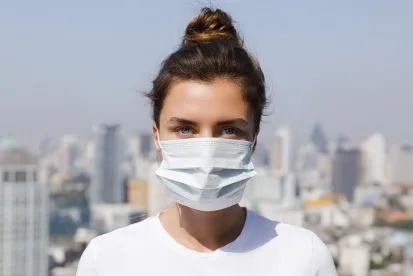Beginning July 27, 2020, Virginia will become one of the first states to implement comprehensive, mandatory safety regulations for employees returning to work during and post-COVID. In a press release last week, Governor Ralph Northam announced that the Virginia Safety and Health Codes Board had voted to adopt an emergency temporary standard, §16VAC25-220, which is designed to “control, prevent, and mitigate the spread of” COVID-19.
The standard provides specific rules and safety precautions that must be taken by every employer and employee in the Commonwealth of Virginia, based on the level of risk exposure the employee is subjected to in his or her job tasks.
Definition of Risk Levels
The emergency standard categorizes job tasks into one of four risk exposure levels:
-
“Very high” risk job tasks are those with high potential for employee exposure to known or suspected sources of the virus. This includes employees who are handling specimens from a patient known or suspected to be infected, or performing an autopsy on a person known or suspected to be infected using aerosol-generating procedures.
-
“High” risk job tasks are those with high potential for employee exposure within six feet of distance with known or suspected sources of the virus, but that are not otherwise classified as “very high risk.” This includes healthcare delivery and support services (such as doctors and hospital staff), and first responders providing services to an individual known or suspected to be infected with the virus.
-
“Medium” risk job tasks are those not otherwise classified as “very high” or “high” risk, in places of employment that require more than minimal contact within six feet of other individuals who may be infected with the virus, but who are not known or suspected to be infected. This includes employees working in commercial transportation of passengers, and employees in correctional facilities, exercise facilities, drug stores, etc.
-
“Lower” risk job tasks are those not otherwise classified as “very high,” “high” or “medium” risk, and which do not require contact within six feet of persons known or suspected to be infected with the virus. This includes employees in an office building setting who have minimal occupational contact with other employees, and curbside package delivery services.
Requirements for All Employers
All employers in Virginia are required to implement the following safety precautions and procedures:
-
Assess workplaces for hazards and job tasks that can potentially expose employees to the virus, and classify each job task accordingly.
-
Encourage employees to self-monitor for signs and symptoms of COVID.
-
Develop and implement policies and procedures for employees to report when they are experiencing COVID symptoms.
-
Do not permit employees known or suspected to be infected to report to or remain at work.
-
Ensure that company sick leave policies are flexible and consistent with public health guidance.
-
Establish a HIPAA-compliant system to receive reports of positive COVID test results, and notify employees who may have been exposed. Notification of positive test results shall also be provided to the building owner; the Virginia Department of Health; and the Virginia Department of Labor and Industry if three or more employees test positive within a 14-day period.
-
Ensure physical distancing is observed, including by using signage or other announcements that promote physical distancing, decreasing worksite density by limiting non-employee access, etc.
-
Provide immediate use of cleaning and disinfectant supplies to employees who interact with the public.
Requirements for All Employees
-
Any employee who is known or suspected to be infected with COVID shall not be permitted to return to work until at least 10 days after symptoms first appeared, or until they receive two consecutive negative COVID tests.
Additional Requirements for “Very High” and “High” Risk Job Tasks
Employers whose employees are engaging in “very high” or “high” risk job tasks must additionally comply with the following:
-
Ensure appropriate air-handling systems are installed and maintained, and requirements for air ventilation are being met.
-
Use airborne infection isolation rooms when available to perform aerosol-generating procedures on patients known or suspected to be infected with COVID.
-
Require prescreening/surveying of employees before each work shift to verify the employee does not have signs or symptoms of COVID.
-
Provide all employees with job-specific education and training on preventing the transmission of COVID.
-
Provide employees with gloves, a gown, a face shield or goggles, and a respirator when in contact with or within six feet of patients or others known or suspected to be infected with COVID.
-
Develop and implement a written Infectious Disease Preparedness and Response Plan.
-
Provide training to all employees on the hazards and characteristics of the virus.
Additional Requirements for “Medium” Risk Job Tasks
Employers whose employees are engaging in “medium” risk job tasks must additionally comply with the following:
-
Require prescreening/surveying of employees before each work shift to verify the employee does not have signs or symptoms of COVID.
-
Where possible, implement flexible worksites (i.e. telework) and flexible work hours (i.e. staggered shifts).
-
Require employees in customer-facing jobs to wear face coverings.
-
Provide training to all employees on the hazards and characteristics of the virus.
“Medium” risk employers with eleven or more employees shall also develop and implement a written Infectious Disease Preparedness and Response Plan.
Anti-Discrimination Provision
Lastly, the new emergency standard prohibits discrimination against any employee for exercising their rights under the standard, for voluntarily providing and wearing their own personal protective equipment, and/or for raising reasonable concerns about infection control.
As you are aware, things are changing quickly and there is a lack of clear-cut authority or bright line rules on implementation. This article is not intended to be an unequivocal, one-size fits all guidance, but instead represents our interpretation of where things currently and generally stand. This article does not address the potential impacts of the numerous other local, state and federal orders that have been issued in response to the COVID-19 pandemic, including, without limitation, potential liability should an employee become ill, requirements regarding family leave, sick pay and other issues.



 />i
/>i

